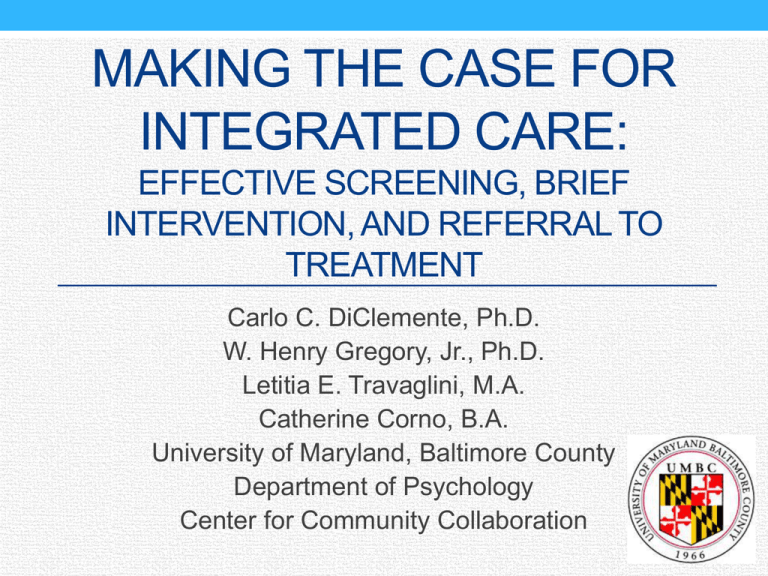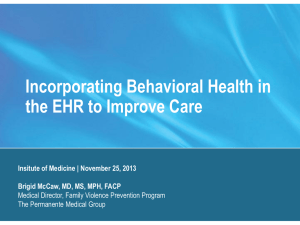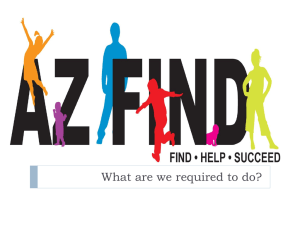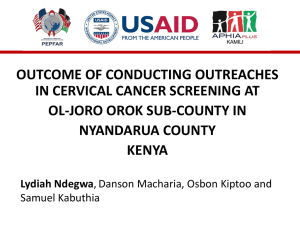
MAKING THE CASE FOR
INTEGRATED CARE:
EFFECTIVE SCREENING, BRIEF
INTERVENTION, AND REFERRAL TO
TREATMENT
Carlo C. DiClemente, Ph.D.
W. Henry Gregory, Jr., Ph.D.
Letitia E. Travaglini, M.A.
Catherine Corno, B.A.
University of Maryland, Baltimore County
Department of Psychology
Center for Community Collaboration
2
Acknowledgements
• No Wrong Door Project
• SAMHSA No Wrong Door (MAI-TCE)
Grant Contract No: SM-11-006
• Maryland Department of Health and Mental Hygiene, Infectious
Disease Bureau, Prevention and Health Promotion Administration
• Kip Castner, M.P.S., Deputy Chief, Center for HIV Prevention and Health
Services
• Carolyn Thompson, M.A., No Wrong Door Project Coordinator
• Danielle Friedman, M.P.H., HIV Prevention Evaluator & Epidemiologist
• Center for Community Collaboration
• Krystle F. Nickles, M.P.P.
• Meagan Graydon, B.A.
• Letitia Travaglini, M.A.
• Tatiana V. McDougall, M.A.
• Daniel Knobloch, M.A.
• Onna Van Order, Ph.D.
• Catherine Corno, B.A.
• Amber E. Q. Norwood, Ph.D.
3
Presentation Outline
• The Need for Integrated Care
• Benefits of Integrated Care
• Integrated Screening
• Tying it all Together: Screening, Brief Intervention &
Referral to Treatment
• Benefits of SBIRT
• The No Wrong Door Project
4
THE NEED FOR
INTEGRATED CARE
5
The Need for Integrated Care
Mental
Health
Physical
Health
Individuals
Seeking
Services
Sexual
Health
Substance
Abuse
It is likely that
individuals who
seek Mental
Health services
have concerns
across many
health domains.
Co-Occurring Disorders
• The perfect place to see the need for client centered
collaboration and for integrated care
• Mutually Complicating Conditions that are significantly
challenging for the individual to manage and together
create an interactive set of problems that involve
biological, psychological, social, spiritual, and systems
dimensions.
• These problems test the breadth and depth of any
treatment program and present significant barriers for
integrated treatment
Multiple Problems – One Person
8
Co-occurring Mental Health &
Substance Use Disorders
36.7 Million
Mental Illness Only
11.2 Million
SUD Only
9.2 Million
COD
A National Survey
(SAMHSA, 2010)
found that 45.9
million adults had a
mental illness in the
past year, and 20.3
million adults had a
substance use
disorder.
Of those two groups,
9.2 million have
both a mental illness
and substance use
disorder.
COD = Co-occurring Disorders
SUD = Substance Use Disorder
9
Mental Health & Medical Conditions
Percent with Medical Conditions
70
Mental health disorders
can exacerbate or be
related to other health
problems and chronic
medical conditions.
60
50
40
Individuals with serious
mental illness die 25 years
earlier than the general
population, largely due to
other risk behaviors and
medical conditions that go
untreated.
30
20
10
0
General Adult
Population
Adults with
Mental Illness
(SAMHSA, 2013a)
10
Percent with Mental Health Diagnosis
HIV Prevalence and Other Disorders
35
General Population
HIV+ Population
Many individuals
with HIV suffer from
co-occurring mental
health and
substance use
disorders at rates
much higher than
the general
population.
30
25
20
15
10
5
0
Any Mood
Disorder
Any Anxiety
Disorder
Any Substance
Use Disorder
(Pence, Miller, Whetten, Eron, & Gaynes, 2006)
11
Percent who are HIV-positive
Severe Mental Illness &
HIV Prevalence
6
HIV prevalence among
people with a severe
mental illness was found
to be 3%, which is 8
times that of the overall
prevalence in the US
Population (0.3-0.4%).
The difference is even
greater between women
with a severe mental
illness and those without.
4
2
0
Men & Women
General Population
Women
SMI Population
(Rosenberg et al., 2001)
12
Prevalence rates of
HBV (23.4%) and
HCV (19.6%) in SMI
populations are
roughly 5 and 11
times the overall
estimated population
rates, respectively.
Percent with Hepatitis diagnosis
Severe Mental Illness &
Hepatitis Prevalence
25
20
15
10
5
0
Hepatitis-B
General Population
Hepatitis-C
SMI Population
(Rosenberg et al., 2001)
13
SMI, HIV, and Hepatitis
Impact of Other Risk Factors
Percent Diagnosed with STI
25
20
There is a dramatic
difference in rates of HIV,
HBV, & HCV infection
within the SMI population
when the individual also
has additional risk factors
(e.g., injection drug use,
substance use disorder,
sex work, other STIs).
15
10
5
0
HIV
HBV
HCV
SMI w/o Other Risk Factors
SMI + Other Risk Factors
(Rosenberg et al., 2001)
14
BENEFITS OF
INTEGRATED CARE
Why Integrated Care?
• Every change of a targeted problem really involves
multiple changes and often is complicated by problems
and changes needed in multiple life domains
• Healthcare providers are facing
this reality particularly with
Non Communicable Diseases
(CVD, COPD, Diabetes,
Addictions) responsible for
63% of mortality worldwide
(WHO, 2012)
16
Benefits of Integrated Care
• We need to treat people not diagnoses
• Focus on the whole person,
rather than one symptom,
issue, or are of concern.
• Ability to focus on overall
health and well-being rather
than illness.
(Chester, 2013; Shim et al., 2012; Stephens, 2012)
17
Benefits of Integrated Care
• Collaboration among different healthcare providers to:
• Improve screening and access to care for multiple health concerns.
• Incorporate preventive strategies across health domains.
• Focusing on primary care concerns of people with mental
illness can reduce the life expectancy gap between those
with SMI and the general population.
• Incorporating mental health screening into primary care
settings can “catch” those individuals who may be initially
reluctant to seek mental health treatment.
(Chester, 2013; Shim et al., 2012; Stephens, 2012)
18
INTEGRATED SCREENING
19
Screening versus Assessment
• Screening
• Identify immediate, current health needs
• Determine need for further evaluation & treatment/support
• Typically short in length and quick to administer & score
• Assessment
• Comprehensive; usually considers all domains of functioning
• Individualized to meet needs & identify strengths
• Gathers key information & enables practitioner to identify health
concerns or diagnoses and identify strengths and barriers that may
impact treatment engagement
• Establishes a baseline of signs, symptoms, behavior to allow
ongoing monitoring of progress
(Technical Assistance Partnership for Child and Family Mental Health, 2013)
20
Why Screen Across Multiple Areas?
• Addresses under- or untreated & preventable conditions
that affect other health conditions
• Reduces barriers to care by
delivering an approach that
meets individuals’ multiple
health needs
• Focused on the WHOLE person
versus focusing on one aspect
known to impact health and
overall functioning
21
Integrated Care Requires
Integrated and Comprehensive Screening
• Unknown problems often complicate care
• Comprehensive care involves identifying not only current
diagnosable problems but also risk behaviors that can
complicate care
• Comprehensive screening is needed to identify critical
problems that are present for an individual seeking
treatment for any disorder
• Although almost all programs do some screening for cooccurring conditions, few look across multiple domains of
risk and use comprehensive screening instruments.
22
Integrated Screening
• Determines the likelihood that an individual is
experiencing problems or concerns across multiple health
domains
• Expedites entry into appropriate services & can include
exploration of service needs (e.g., medical, housing,
trauma, etc.)
• Goal is to identify individuals who may have co-occurring
disorders & related service needs
• Individuals who screen positive are then referred to in
depth assessment
(SAMHSA, 2013b)
23
PUTTING IT ALL TOGETHER:
SCREENING,
BRIEF INTERVENTION, AND
REFERRAL TO TREATMENT
24
Possible Outcomes
• Negative Screen: No further action required
• Positive Screen: Brief Intervention
•
For clients with low interest in addressing concerns/changing
behavior
•
Plant a seed for future change
• Positive Screen: Brief Intervention & Referral
•
For clients with greater interest in addressing
concerns/changing behavior
•
Refer for further assessment and/or treatment
•
Take advantage of “teachable moments” to capture attention
and motivate change
(Center for Community Collaboration, 2012)
“The way in which you talk with patients
about their health can substantially
influence their personal motivation for
behavior change.”
~Rollnick & Miller, developers of
Motivational Interviewing
The Style that Works Best
with Brief Interventions
• Patient centered communication
• Motivational Interviewing (MI) Style/Spirit, which includes:
• Empathy and collaboration
• Caring concern
• Appreciation for patient’s experiences and opinions
• Aiming to elicit patient’s motivation to change
Brief Intervention is a Best Practice in
Tobacco Cessation
• “All physicians should strongly advise every patient who smokes
to quit because evidence shows that physician advice to quit
smoking increases abstinence rates.”
• “Minimal interventions lasting less than 3 minutes increase overall
tobacco abstinence rates.”
• “Every tobacco user should be offered at least a minimal
intervention, whether or not he or she is referred to intensive
intervention.”
Recommendations with Strength of Evidence = A
• Fiore et al. (2008). Treating Tobacco Use and Dependence: Clinical Practice
Guideline 2008 Update.
28
Determine Referral Need
• 3 referrals based on level of risk/symptom severity and
client’s response to BI:
• Self-Help, Mutual Help, Group Support: Discuss with clients
who are at lower risk and interested in making changes on their
own
• Initial Evaluation/Assessment: Refer to provider within health
domain to determine diagnosis and appropriate treatment
options
• Emergent Care/Treatment: Client with severe symptoms or at
high risk may need same-day referral for emergency care
services
(Center for Community Collaboration, 2012)
29
Identify Referral Options
• Discuss and negotiate with client
• Develop a referral plan that is:
• Effective: good, well-matched referral based on client need
• Accessible: cost/insurance; transportation; plan to address
barriers
• Acceptable: negotiate where client is willing to go based on
referral recommendations and his/her prior experiences
(Center for Community Collaboration, 2012)
Adequacy of the Referral
• Communication styles that impact treatment engagement
and adherence
• Hot Handoff
• Matching patient to provider, aiding in Direct contact, Meet-n-greet
• Warm Handoff
• May match patient to provider, indirect notification to provider (e.g.,
note in chart, electronic message)
• Cold Handoff
• No notification to provider, requires self-activated referral by patient
(Center for Community Collaboration, 2012)
31
BENEFITS OF SBIRT
32
Benefits of SBIRT
• Reduction of Monetary Costs
• Reduces healthcare costs
• Reduces employee costs due to absenteeism and impaired
performance
• Reduction of Risky Behaviors: fewer hospital admissions,
fewer injuries, reduced substance use
• Promotion of Healthy Behaviors: more stable housing,
employment, fewer arrests, improved emotional & overall
health
(Madras, et al., 2009; Quanbeck et al., 2010)
33
SBIRT and the Affordable Care Act
• ACA recognizes the importance of screening &
intervention in primary care settings
• As of 10/14/11, Medicare covers screening & behavioral
counseling in primary care settings
• Essential Health Benefits through the ACA (including
mental health and substance use disorder services at
parity with other medical care) promotes SBIRT across
multiple healthcare settings
(Centers for Medicare and Medicaid Services, 2011; Department of Health and Human Services, 2011)
34
THE NO WRONG DOOR
PROJECT
Integrated Care in the
Baltimore-Towson Metropolitan Statistical Area
35
Maryland’s No Wrong Door Project
• Aim of NWD: Improve integration & comprehensiveness of
direct services & referral networks for:
• Mental Health Treatment
• Substance Use Treatment
• Primary Care Services
• Infectious Disease Services: HIV and other STIs
• Integrated Screening Instrument: comprehensive, innovative
instrument that briefly evaluates & identifies client risks and
allows for appropriate treatment planning and referrals
• Development of an Integrated Referral Network: establishing
an integrated referral network to provide effective and
appropriate linkages to care for individuals seeking health
services
36
Overview of Integrated Screening
Instrument
• Comprehensive: screens for risk and affectedness
across several health domains
• Adaptable: can be administered in its entirety or
according to specific modules
• Flexible:
• Self-administration and Interview formats
• Electronic and Hard-copy (paper & pencil) formats
• can be used at intake or at different points throughout
treatment/involvement in agency
37
Outline of Integrated Screening
Instrument
Physical
Health/
Primary Care
General Health Status
(pain, mobility,
disability)
Mental
Health
Substance
Abuse
Sexual
Health/
ID Risk
Depression
Alcohol Use
Sex/Drug-Linked
Behavior
Anxiety
Illicit Drug Use
Risky Sexual Behavior
Linked to Primary
Care
Pregnancy/Prenatal
Care
Trauma
Non-prescription use
of Prescription
Medications
Suicide
Tobacco Use
Resiliency Factors
(social health,
self-esteem)
Sex/Drug-Linked
Behavior
Other Risk Behavior
(incarceration,
needle sharing)
HIV/Infectious
Disease Testing &
Treatment
38
Elements of the Screener - 1
Mental Health
Physical
Health
DUKE
PCPTSD
SBQ-R
AUDIT
ASSIST
HRBC
NWD Integrated
Screener
Demographics
✓
Primary Care
✓
Physical Health
✓
✓
Resiliency Factors
✓
✓
Anxiety
✓
✓
Depression
✓
✓
Social Health
✓
✓
Self-Esteem
✓
✓
Trauma
Suicidality
✓
✓
✓
✓
39
Elements of the Screener - 2
DUKE
SBQ-R
HRBC
ASSIST
✓
✓
✓
Tobacco Use
✓
✓
Illicit Drug Use
✓
Rx Drug Use
✓
✓
✓
✓
Sex/Drug- Linked
Behavior
Infectious Disease
NWD Integrated
Screener
AUDIT
Alcohol Use
Substance Use
PCPTSD
✓
Sexual Behaviors
✓
✓
Other ID Risk
✓
✓
(Prison; Injection Drug Use)
HIV/ID Testing
✓
HIV Treatment
✓
40
Case Example 1: Lloyd
• 23-year-old single African American male
• High school graduate; working as a plumber’s assistant for 3
•
•
•
•
•
years
Active social life with friends; no girlfriend but has had 3 female
sexual partners in past year; usually wears condoms
Currently drinks alcohol & shoots speedballs (cocaine &
heroin); history of other drug use
Has been complaining of stomach pain that feels like “multiple
stab wounds that goes on for hours”
Tested positive for HIV last year; has difficulty paying for
medications
Has thought about suicide as a way to end his life if his disease
progresses to AIDS.
Physical & Mental Health Status
41
42
Mild depressive symptoms
Suicidal ideation
Severe pain
Some general health
concerns
Good self-esteem & social relationships
43
Substance Use
ALCOHOL USE
ILLICIT DRUGS
44
Substance abuse
treatment referral
recommended due
to alcohol and illicit
drug (cocaine &
heroin) abuse.
45
46
Case Example 2: Jessica
• 28-year-old married Caucasian female
• Second year medical resident in a large hospital
• Past few weeks endorsed the following:
• Feelings of worthlessness; low mood; tearfulness
• Tiredness; difficulty falling and staying asleep
• Difficulty concentrating
• Irritability
• Withdraw/not spending time with friends or on pleasurable activities
• Increased dissatisfaction with life; frequent thoughts of wishing she
were dead
• Drinks a few glasses of wine a couple of times per week
“to help [her] sleep”
47
Mental
Health
Status
48
Substance (Alcohol) Use
49
50
Putting It All
Together:
Each component of the
Screening, Brief
Intervention, and Referral
to Treatment (SBIRT)
process is crucial in
providing early
identification & linkages to
care.
When SBIRT is
successful, you will see
positive outcomes in
clients!
(Center for Community Collaboration, 2012)
51
References
•
•
•
•
•
•
•
•
•
•
•
•
•
•
Chester, E. (2013). Life expectancy gap widens between those with mental illness and general population. British Journal of
Medicine Editorial.
Center for Community Collaboration (2012). SBIRT for Mental Health and Substance Use: Screening, Brief Intervention, & Referral to
Treatment Implementation Guide for HIV Care Services Programs. Unpublished manuscript, University of Maryland, Baltimore
County.
Centers for Medicare and Medicaid Services (2011). Medicare Claims Processing Manual: Chapter 18 – Preventive and Screening
Services. Retrieved September 11 2013 from www.cms.gov/Regulations-and-Guidance/Guidance/ Manuals/
downloads//clm104c18.pdf.
Department of Health and Human Services (2011) ‘Essential Health Benefits Bulletin. Available at:
http://cciio.cms.gov/resources/files/Files2/12162011/essential_health_benefits_bulletin.pdf.
Madras, B. K., Compton, W. M., Avula, D., Stegbauer, T., Stein, J. B., & Clark, H. W. (2009) Screening, brief interventions, referral to
treatment (SBIRT) for illicit drug and alcohol use at multiple healthcare sites: comparison at intake and 6 months later. Drug and
Alcohol Dependence, 99, 280-295.
Pence, B. W., Miller, W. C., Whetten, W., Eron, W. W. Jr., Gaynes, B. N. (2006). Prevalence of DSM-IV-defined mood, anxiety, and
substance use disorders in an HIV clinic in the southeastern US. JAIDS, 42, 298-306.
Quanbeck, A., Lnag, K., Enami, K., & Brown, R. L. (2010). A cost-benefit analysis of Wisconsin’s screening, brief intervention, and
referral to treatment program: Adding the employer’s perspective. State Medical Society of Wisconsin, 109, 9-14.
Rosenberg, S. D., Goodman, L. A., Osher, F. C., Swartz, M. S., Essock, S. M., …Salyers, M. P. (2001). Prevalence of HIV, Hepatitis
B, and Hepatitis C in people with severe mental illness. American Journal of Public Health, 91, 31-37.
Shim, R. S., Koplan, C., Langheim, F. J. P., Manseau, M., Oleskey, C., Powers, R. A. & Compton, M. T. (2012). Health care reform
and integrated care: A golden opportunity for preventive psychiatry. Psychiatric Services, 63, 1231-1233.
Stephens, S. (2012). Collaborative care teams improve mental health outcomes. Health Behavior News Service.
Substance Abuse and Mental Health Services Administration (SAMHSA, 2010), Results from the 2010 National Survey on Drug Use
and Health: Summary of National Findings, NSDUH Series H-41, HHS Publication No. (SMA) 11-4658. Rockville, MD: Substance
Abuse and Mental Health Services Administration.
Substance Abuse and Mental Health Services Administration (SAMHSA, 2013a). Co-occurring Disorders and Primary Care.
Retrieved July 15, 2013 from http://www.samhsa.gov/co-occurring/topics/primary-care/index.aspx.
Substance Abuse and Mental Health Services Administration (2013b). Integrated Screening and Assessment. Retrieved 25 February
2013 from http://www.samhsa.gov/co-occurring/topics/screening-and-assessment/index.aspx.
Technical Assistance Partnership for Child and Family Mental Health (2013). Screening vs. Assessment: What is the Difference?
Retrieved 25 February 2013 from http://www.tapartnership.org/content/mentalHealth/faq/01screening.php.
52
Contact Info:
Center for Community Collaboration
University of Maryland, Baltimore County
Department of Psychology
1000 Hilltop Circle, Baltimore, MD 21250
Phone: 410-455-5840
Fax: 410-455-3866
Email: ccc.umbc@gmail.com
Website: http://centerforcommunitycollaboration.org






